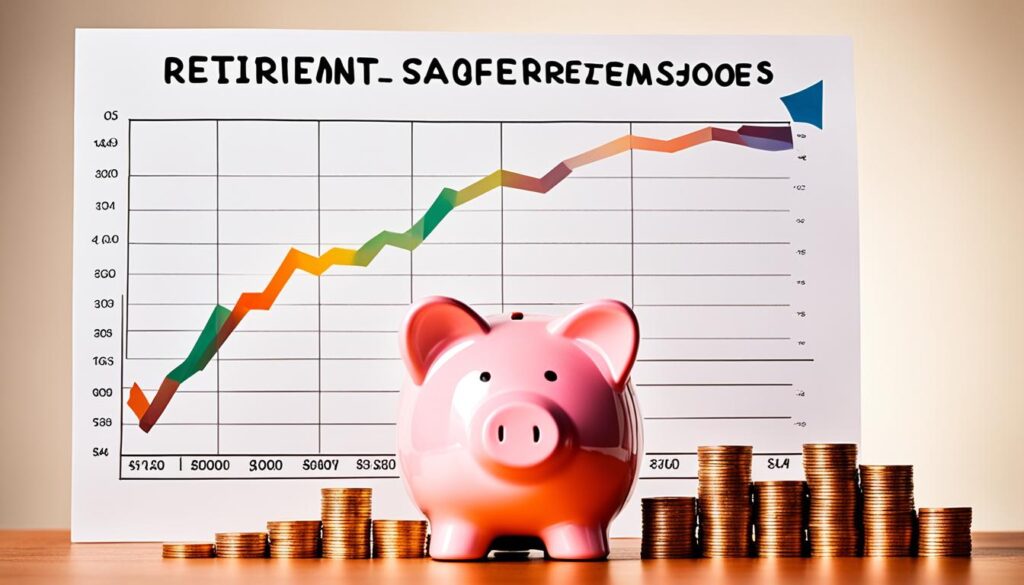More than half of Americans retire before they hit 65. Some go even further, embracing the FIRE lifestyle. This approach isn’t just about quitting work early. It’s about freedom and retiring sooner by being smart with money. We’ll dive into how this movement is changing the American Dream and how people are finding freedom in their finances.
Getting financially independent is tough. It demands changing how we spend, saving a lot, and always thinking ahead. We’ll show you how the FIRE lifestyle works. Plus, how it could let you take charge of your time and live life your way. We’ll cover the basics and share tips for making it work for you.
Key Takeaways
- Understanding the FIRE movement’s potential to facilitate retiring earlier than traditional standards.
- Exploring the structural approach and disciplined habits required to attain financial independence.
- Appreciating the FIRE lifestyle as a customizable journey, tailored to individual financial and life goals.
- Insights into the retire early strategy, which allows for a focused, structured, and strategic path to retirement.
- Highlighting the psychological freedom that comes with financial autonomy and the freedom to choose how to spend one’s time.
What is the FIRE movement?
We often dream about a life free from the regular 9-to-5 grind. The FIRE (Financial Independence, Retire Early) movement offers a plan for such freedom. It focuses on early retirement planning and financial independence. This idea has inspired many to live life on their own terms.
- Living Frugally: This means making smart choices to save a lot of money. It could involve reducing unnecessary expenses or choosing less costly alternatives for everyday things.
- Minimalist Lifestyle: This focuses on simplicity and cutting back. It’s about avoiding unneeded spending and habits that waste money.
- Investment Strategies: A key part of FIRE is how savings are invested. It’s not just saving, but also growing your money through wise investments.
Investment strategies and a minimalist lifestyle can speed up the wealth accumulation for early retirement. This journey demands discipline but is not a dull trek to the end. Living frugally often brings happiness by showing the value of life beyond money.
“The goal isn’t to figure out how to retire as quickly as possible; the goal is to figure out how to build a life that you don’t want to retire from.”
But, there’s no one way to achieve the FIRE movement’s goals. Below, a table compares different paths to financial independence and early retirement planning.
| Approach | Description | Pros | Cons |
|---|---|---|---|
| Traditional | Working until the age of 65 before retiring. | Stable income up to retirement age; employer-provided benefits. | Later start to retirement; less freedom during working years. |
| FIRE | Aggressive savings and investments to retire much earlier than traditional methods. | Early financial independence; long, self-directed retirement. | Requires high income and/or very frugal living; potentially higher risk. |
| Coast FIRE | Saving enough to let investments grow, reducing the need to save actively for retirement. | More flexible work-life balance; less stress later on. | Needs early financial commitment; could mean a longer work period if not careful. |
Join us in exploring the challenge of early retirement planning. Let the FIRE movement inspire you to control your financial future. Imagine a life where financial needs don’t limit you, but your choices do. This isn’t just a dream. It’s possible with dedication to financial independence, living frugally, and a minimalist lifestyle.
How does FIRE work?
Starting the FIRE journey means more than just saving money. It involves financial planning and lifestyle changes for FIRE. We look at changing our habits, boosting our savings strategies, and starting passive income streams.
Financial planning is key to FIRE. It requires us to carefully map out our money plans, setting SMART goals from the start. This way, we make sure every dollar is used well, like in investments or savings.
Savings are core to FIRE. We should examine our spending on big items like housing, transport, and food. By making small changes, like a smaller home or a plant-based diet, our savings strategies grow.
Passive income streams help us reach early retirement. This could be stock dividends, rental property income, or creative work royalties. They boost our savings without extra work.
Small lifestyle changes for FIRE matter too. Skipping the daily coffee shop, using public transport, or cheap hobbies can save a lot of money.
- Set clear financial goals.
- Create a savings-focused budget.
- Cut out unnecessary expenses.
- Look for ways to earn more.
- Invest to get passive income.
- Make lifestyle choices that support FIRE.
Let’s see a real-world comparison of savings with FIRE:
| Expense Category | Before FIRE | After FIRE Adjustments | Annual Savings Increase |
|---|---|---|---|
| Housing | $1,500/month | $1,000/month | $6,000 |
| Transportation | $300/month | $100/month | $2,400 |
| Groceries | $600/month | $400/month | $2,400 |
| Dining Out | $250/month | $100/month | $1,800 |
| Entertainment | $200/month | $50/month | $1,800 |
| Total Annual Savings | $14,400 |
Changing how we spend boosts our investment funds. These numbers can differ for everyone, but they show FIRE’s possible path.
Being consistent and creative with money management helps retire early. FIRE aims for enough savings and passive income to leave 9-to-5 jobs behind. This leads to financial independence and a happy retirement.
The rule of 25 and 4% rule
Two key financial benchmarks are crucial for planning retirement. They help hopeful retirees draw a roadmap to their savings goals. Let’s dive into the details of these strategies.
Rule of 25
The Rule of 25 states that saving 25 times your yearly expenses will help achieve financial freedom. Simply multiply your annual expenses by 25 to figure out your target. For instance, if you spend $40,000 a year, aim to save $1 million.

Consider a varied retirement investment strategy to grow your savings. Mixing stocks, bonds, and other assets can fight inflation. This way, your purchasing power stays strong during retirement.
The 4% Rule
The 4% rule works well with the Rule of 25. It suggests a 4% yearly withdrawal from your savings. This pace helps your funds last longer, aiming for a worry-free retirement.
For a $1 million savings, withdrawing $40,000 in the first year is the idea. Adjust for inflation in the following years. Remember, the 4% rule relies on past market trends and isn’t perfect. Changes in the market or your personal life might require strategy tweaks.
In summary, these rules are just the starting line. Your retirement plan will be unique to you. So, use the Rule of 25 and the 4% rule as guides. Stay flexible and adjust as necessary. This approach will help ensure a stable and happy retirement.
The right savings rate
Getting to our financial goals means maximizing savings is key. It’s essential for personal finance optimization. A well-thought-out savings rate acts as a bridge. It helps us move from earning to enjoying our investments.
The perfect savings rate? It’s how much of your income should be saved to retire comfortably. We aim to give you the tools to customize your savings. This way, it fits your financial situation and life plans.
“The art is not in making money, but in keeping it.” – Proverb
- Analyze Your Expenditure: Look over your spending to see where you can cut back without losing joy.
- Incremental Increases: Boost your savings bit by bit. Even 1% more can make a big difference over time.
- Explore Additional Income: Find more ways to make money. This strengthens your ability to save without scrimping too much.
We’re after a balance. We want a joyful life but also a growing bank account.
Let’s dig deeper:
| Income Bracket | Essential Expenses | Luxuries/Discretionary | Suggested Savings Rate |
|---|---|---|---|
| $50,000 – $70,000 | 50-60% | 10-20% | 20-30% |
| $70,001 – $100,000 | 45-55% | 10-15% | 30-40% |
| $100,001+ | 40-50% | 5-15% | 40-50% |
The more you earn, the more you can save without giving up comforts. Saving for emergencies, a home, or retirement requires a flexible plan. And dedication.
Being aware of life’s ups and downs is crucial. It lets us adjust while keeping our financial goals in sight. Let’s celebrate each success and each dollar saved as we go.
The magic of compound growth
Exploring the path to investment growth reveals the marvel of compounding interest. This concept is a cornerstone of strategies to retire early. Let’s delve into how compounding interest works wonders for long-term investments.
Think of planting a seed. With care, it sprouts, grows, and produces more seeds. Investment growth via compounding is similar. By reinvesting earnings, you earn on both your initial amount and the gains over time.
- Start Early: Time allows compounding to magnify your savings.
- Regular Contributions: Consistent investments speed up growth.
- Reinvest Dividends: Putting dividends back into your investment amplifies compounding.
- Patience Pays: Long-term thinking beats short-term gains.
“The strongest force in the universe is Compound Interest” – Albert Einstein
Many have found financial freedom using this approach. They wisely invested in assets like stocks, bonds, and index funds. Compounding, over decades, significantly increased their wealth.
Our aim is to enlighten you on the power of compounding interest. It’s crucial for financial independence. We’re here to help every step of the way.
Tax-efficient strategies
Reaching financial independence and the FIRE lifestyle comes with big perks. One key is tax planning for retirement. Savvy investors realize that smart tax decisions with investments boost their savings big time. By following IRS savings guidelines, we use all tax breaks to our advantage.
Here’s how to benefit from tax-smart moves:
- Roth IRAs grow tax-free for retirement, perfect if you expect higher taxes later.
- Traditional 401(k)s cut current taxes, deferring them to possibly lower-tax retirement years. This gives an instant tax savings.
- Health Savings Accounts (HSAs) offer triple tax benefits for medical costs with pre-tax dollars. Contributions are deductible, earnings grow tax-free, and medical withdrawals aren’t taxed.
Diving into investment options like index funds and municipal bonds also helps save on taxes. Choosing investments wisely for tax reasons can save a lot of money.
“The key to tax planning for retirement is to understand the interplay between different types of accounts and the tax implications of each.” — a renowned tax strategist
Investing in a mix of tax-favored accounts spreads out taxes and ensures tax-smart retirement savings. It’s not just saving, but saving wisely.

The FIRE journey isn’t only about your income or savings. It also depends on keeping more money after taxes. That’s why staying up-to-date on tax laws is crucial. This way, we make the most of tax planning for retirement and optimize our investments for taxes.
Types of FIRE
We talk about early retirement, there are different views within the FIRE community. Each one is unique in its approach to frugal living and how to plan finances. These FIRE types help people move towards retirement, whether they want a simple life or a luxury one.
Lean FIRE: The Essence of Minimalist Retirement
Lean FIRE means living simply and spending very little. It’s perfect for people who want a humble life. They cut costs a lot to make their savings last longer. We have stories and tips for those who want to try this way of living:
“Lean FIRE isn’t just about saving money; it’s about prioritizing what truly matters and eliminating the excess.”
Fat FIRE: A High-Budget Path to Early Retirement
Fat FIRE is for those who want a fancy retirement. It’s about having enough money to live comfortably. This way involves earning well and investing wisely. This helps create a big savings pot for a luxury life. Here are some ways to achieve Fat FIRE:
- Investing in high-yield assets
- Building multiple income streams
- Planning for long-term wealth preservation
Barista FIRE: Combining Work and Play
Barista FIRE means working part-time after leaving a full-time job. This helps cover living costs and health benefits. It mixes a bit of work with enjoyment. Here’s what you can do to balance Barista FIRE:
- Choosing fulfilling part-time work
- Aligning work with personal passions
- Considering work that offers desired benefits
Choosing your FIRE path depends on your needs. It’s not a one-size-fits-all situation. Here’s a chart to show differences between each FIRE type.
| FIRE Type | Lifestyle | Retirement Budget | Investment Focus |
|---|---|---|---|
| Lean FIRE | Minimalist | Low-Cost | Cost-cutting, Low-expense Investments |
| Fat FIRE | Luxurious | High-Budget | Diverse Income Streams, High-yield Investments |
| Barista FIRE | Work-life Integrated | Moderate Spending | Part-Time Income, Essential Benefits |
No matter which FIRE you choose, the aim is the same. You want to live sustainably and according to your retirement dreams. It could mean shifting to part-time work or aiming for a simple or fancy retirement. You have the tools of careful spending and smart planning.
Limitations of FIRE
Embarking on a journey to financial independence and perhaps retiring early (FIRE) can be truly freeing. Yet, it’s not without its early retirement risks. The path to FIRE isn’t easy or clear for everyone. Through research and our own experiences, we’ve identified several financial independence challenges that need attention.
One big challenge is market volatility. Investment returns can change a lot, which may upset carefully made FIRE plans. We need to be ready for financial ups and downs. Another major issue is unexpected healthcare costs. With medical care getting more expensive, a sudden illness can use up savings quickly.
We need to understand the downsides of FIRE. This means looking closely at potential risks and how they fit with FIRE principles. A good FIRE strategy is one that can change with life’s unexpected moments.
| Challenges | Impact on FIRE Strategy |
|---|---|
| Market Volatility | Can cause big changes in investment value, needing adjustments in how much money you take out and possibly delaying when you retire. |
| Unforeseen Expenses | Might mean using savings early, which could make retirement funds run out sooner and may lead to working again. |
| Rising Healthcare Costs | Could increase more than planned for in the FIRE strategy, needing more savings or extra insurance. |
| Inflexibility in Lifestyle | Sticking to a strict budget and simple living key to FIRE might be hard to keep up, causing potential stress. |
Diving deeper into FIRE’s limitations, we see more concerns. Critics say not everyone can achieve financial independence due to economic differences and hard saving in today’s job market. It’s important to think about if FIRE fits with your values and life goals.
In conclusion, talking about the limitations of FIRE isn’t meant to discourage anyone. Instead, it’s to make those on the FIRE path more ready. Knowing and preparing for these issues can make your FIRE plan stronger, keeping your dream of FIRE exciting and possible.
Next steps
As we approach the end of our journey in the FIRE movement, we focus on steps for your financial freedom. Creating an action plan for early retirement is an ongoing process. It involves learning about finances, changing your lifestyle, and saving diligently. It’s about making a plan that fits your dreams of being financially free.
But learning about money doesn’t stop when you retire early. Continuing financial education is key to keeping your financial future secure. You need to stay updated on financial news to keep your knowledge fresh. This ensures your investments grow strongly over time. Keeping an eye on your finances and adjusting your plans when necessary are crucial steps to keep your financial freedom.
In our search for financial independence, the support of others is priceless. Talking and sharing ideas with people who have the same goals strengthens our determination. Let’s commit to being patient, persistent, and adaptable. We’ve learned about the FIRE movement’s strategies together. Now, with knowledge and enthusiasm, we’re ready to achieve the freedom and wealth we aim for.
